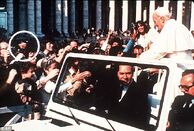| |||||||
| Capital (and largest city) |
Vatican City (City-state) | ||||||
| Language | Italian | ||||||
| Religion | Roman Catholicism | ||||||
| Legislature | Absolute monarchy, ecclesiastical and elective theocracy | ||||||
| Area | 0.44 km² | ||||||
| Independence | from Kingdom of Italy | ||||||
| declared | February 11, 1929 | ||||||
The Vatican City is a city-state within Rome, Italy. It is the home of the Pope and the center of the Catholic Church; and is the spiritual successor to the historic Papal States. The term is used to cover the temporal jurisdiction, with the Holy See - sometimes treated as a synonym - being the the episcopal jurisdiction.
History[]
Pre-War[]
The Vatican has been the seat of the Roman Catholic Church since the Papal States. It was initially part of the Kingdom of Italy until it became independent on February 11, 1929 during the signing of the Lateran treaty. As the Italian Social Republic was formed as an Italian puppet state of Nazi Germany, relations with the fascists were strained. The Vatican was nearly spared from an attack from the Axis, but fortunately the neutrality was respected. Controversy surrounded whether the Vatican remained silent about the Holocaust, however recent files show the Vatican did secretly approve of Operation Valkyrie in 1944. The city itself witnessed the liberation of Rome by the Allied Forces.

Mehmet Ali Ağca (encircled) points a Browning HP as Pope John Paul's Popemobile approaches the crowd, May 13, 1981.
Much throughout the Cold War, the Vatican heavily condemned the Soviet Union and much of the Iron Curtain over its oppression of freedoms and religion. Pope John Paul II began his papacy on October 16, 1978. Of Polish ancestry, he heavily condemned the communist regime in Poland and the entirety of Eastern Europe. The first attempted assassination of Pope John Paul II took place on Wednesday, 13 May 1981, in St. Peter's Square at Vatican City. The Pope was shot and wounded by Mehmet Ali Ağca while he was entering the square. The Pope was struck four times, and suffered severe blood loss. Ağca was apprehended immediately, and later sentenced to life in prison by an Italian court. The Pope later forgave Ağca for the assassination attempt.
World War III[]
The city-state remained neutral, but the risk of Soviet or Warsaw Pact spies remained, as well as the threat of Soviet bombers since the city was located in the heart of Rome. As a result, the local Rome police, the Army of the Carabineiri, and the Swiss Guards increased their security. Since Italy somehow provides defense for the Vatican, Italian Army troops and armored vehicles protected the city. Throughout the war, Pope John Paul II often called for both sides to end the conflict and find peaceful means, all while expressing for reforms to occur in Eastern Europe during the Vatican masses which were attended by thousands worldwide. During these masses, security increased threefold.
In the event of the Soviet attack, the Swiss Guards planned to move the Pope to neutral Switzerland - something that did not happen since the Soviets only occupied a portion of northern Italy.



